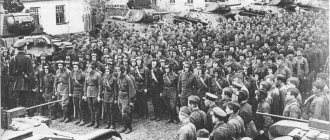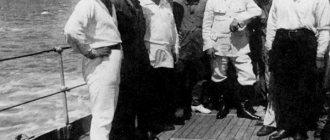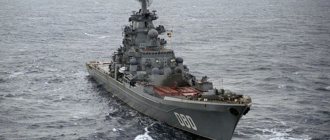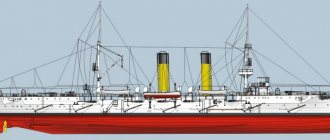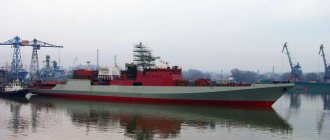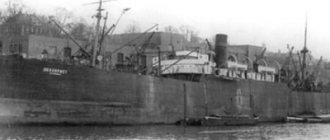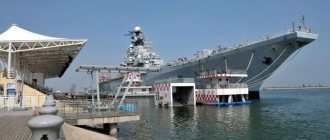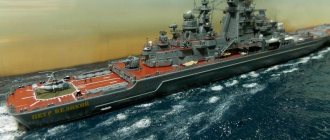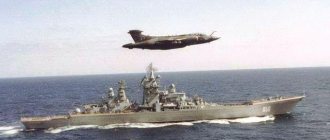Farewell cruise
The cruise ship "Admiral Nakhimov" left Odessa on August 29, called at Yalta and Novorossiysk, then had to go through Sochi to Batumi and return back to its home port. Travel time is seven days. There were 897 passengers and 343 crew members on board. The weather was warm and the sea was calm. The ship arrived at the Novorossiysk port as scheduled at 14:00 on August 31, the passengers went for a walk around the city. At 22:00 the ship was supposed to go to sea and head to Sochi.
Nakhimov_2
Cruise ship "Berlin". 1920s
Photo: The Library of Congress/loc.gov
Smoke underwater: the submarine crew fought for life until the last moment
The investigation into the tragedy in the Barents Sea, on behalf of the president, was taken under personal control by the head of the Ministry of Defense
This was the last, farewell voyage of the liner - back in July, the Black Sea Shipping Company signed a decision to write off the ship for scrap. The fact is that the ship was already in its seventies - it was built in 1925 in Germany and initially sailed in the North and Baltic Seas under the name "Berlin". During the war, it was converted into a floating hospital and already in 1945 it hit a mine and sank. The ship was recovered by Soviet divers, repaired, renamed Admiral Nakhimov and converted into a cruise ship. For several decades it plied the oceans, but when new safety standards were adopted around the world, it had to be removed from international lines. So the ship found itself locked in the Black Sea and began to carry out domestic cruises. The problem was that seafarers were reluctant to go on domestic flights. As a result, “Admiral Nakhimov” turned into a kind of “penal battalion”, where they sent violators of discipline or those who, for various reasons, were not allowed to work on foreign lines. However, this does not mean that the crew was unskilled, but rather that they did not work well enough.
Nakhimov_1
Cruise ship "Admiral Nakhimov" in the Black Sea
Photo: RIA Novosti/Yuri Kaplun
The April 7 tragedy: could the Komsomolets nuclear submarine disaster happen again?
The domestic submarine fleet is not immune from new incidents with serious consequences
The ship was commanded by 56-year-old Vadim Markov, an experienced sailor who had been driving ocean liners for many years. They said that he came under suspicion of currency smuggling, so his travel was temporarily blocked and he was sent to the Admiral Nakhimov. At 10 p.m., strictly according to schedule, the captain ordered the mooring lines to be released, and the ship began to turn around. Already while moving, the ship stopped the cars for a short time and took on board a passenger who had caught up with it on the boat, who turned out to be KGB General Krikunov. However, a ten-minute hitch could not affect the overall situation. Captain Markov inquired about the situation, and he was informed that the dry cargo ship (bulk carrier) Pyotr Vasev was moving towards the liner from the Bosporus. There were no other ships nearby. From the Vessel Traffic Control Post (VTS), the captain of the Peter Vasev was asked to let a passenger ship pass, to which the captain of the dry cargo ship, Viktor Tkachenko, agreed.
"Black list"
In 1948, for example, newspapers sparingly reported about an accident on the ship Pobeda, which was on a special flight from New York to Odessa. There was only a day left before arriving at the destination port, but then a fire started on board. According to the official version, the film caught fire during rewinding. This happened in the pantry, from where the flames quickly spread throughout the ship. It was not even possible to send a distress signal in time, because the radio burned out almost immediately. More than 40 people died on the ship, including Chinese Marshal Feng Yuxiang, a hero of the war with Japan, and a famous politician, so the version of arson arose immediately.
In August 1950, the pleasure steamer Mayakovsky sank in Riga, on the Daugava. The day turned out to be hot, there were many people who wanted to ride along the river, and the crowd simply did not allow passengers from the previous flight to leave. People literally stormed the Mayakovsky, and as a result the ship tilted and began to draw water. A pleasure boat designed for 150 people ended up with 350 at once. About 150 people died, including many children.
In June 1983, a tragedy occurred on the Volga. The passenger ship "Alexander Suvorov" near Ulyanovsk entered under a low, non-navigable span of the bridge. The ship's wheelhouse and upper compartment were blown away, and at the same time a freight train was crossing the bridge, which did not have time to slow down. 176 people died, mostly spectators who were at that time in the cinema hall on the upper deck of the Suvorov.
"Alexander Suvorov" after the disaster. (factroom.ru)
At the beginning of 1986, the ship "Mikhail Lermontov" sank, although far from its native shores. It was one of the few Soviet international cruise ships, and foreign tourists also traveled on it. While passing through the Cook Strait, the Lermontov came across an underwater rock and received a huge hole. One person died then.
And although among the listed disasters there were those that caused great casualties, the death of the Admiral Nakhimov stands apart in this series. On August 31, 1986, a few kilometers from the port of Novorossiysk, a passenger ship collided with the cargo ship Pyotr Vasev. "Nakhimov" sank in just 8 minutes. More than 400 people died in the Black Sea, making this one of the largest disasters involving Soviet civilian ships.
Heroes. And others
Hour of glory: how the proud “Varyag” did not surrender to the enemy
An Austrian poet wrote a song about the cruiser
Those who were in the cabins on the lower decks had virtually no chance of salvation. Moreover, not all passengers appreciated the danger and rushed upstairs - many began to collect things, look for money and documents. But those who tried to get up could not always find a way out, since the eight-deck ship was a real labyrinth, and it was not easy to understand the complex interweaving of its compartments and stairs. There was complete darkness all around, and the ship had already tilted more than 45 degrees.
The situation was slightly better for those upstairs in the dance hall, discotheque, bars and restaurants of the liner. There were a lot of people there - on the last Sunday in August, according to tradition, Miner's Day was celebrated, and the miners walked widely. The impact knocked people to the floor and many were injured. Chairs, tables, sun loungers and other loose objects flew across the tilted deck. In the darkness, people rushed around the ship, not understanding what to do: everyone was waiting for instructions from the command staff, but none came. There were not enough life jackets - individual ones intended for passengers were in the cabins, and the emergency supply still had to be found and distributed.
Nakhimov_3
Divers of the rescue ship "Amethyst" before diving to search for those missing after the sinking of the cruise ship "Admiral Nakhimov". September 7, 1986
Photo: TASS/Vladimir Velengurin
Novik's last voyage
A legendary ship of the Russian fleet was found in the Baltic
The crew members behaved differently - some thought only about their own salvation, others tried to help people without thinking about themselves. The mechanics miraculously managed to shut down the steam engine, otherwise the boilers could have exploded from contact with cold water, and there would have been many more deaths. They had no chance of climbing up from the flooded engine room. Fighting for the life of the ship, chief mate A. Maglysh, chief mechanic I. Dekhtyarev, and senior mechanic G. Yurkin died. Librarian Tatyana Dymkova and flight attendants Tatyana Fedorova and Vera Fedorchuk behaved heroically, handing out vests and escorting passengers out until the very end. They did not have time to leave the internal compartments and died along with the ship. Boatswain William Loboda and several sailors immediately rushed to lower boats and rafts, which saved many lives...
When the liner sank, about a thousand people found themselves in the water among the wreckage of furniture, spilled fuel and paint stored in barrels on the deck of the Nakhimov. People clung to the wreckage and life rafts, but there were too few of them. Those who were stronger risked swimming to the shore, which was four kilometers away. It turned out that many did not know how to swim at all or had difficulty staying on the water. But not everyone had vests. The sea was rough; by the middle of the night the wave reached two meters.
The first to come to the rescue was the pilot boat LK-90, which went out to meet the “Peter Vasev”, and therefore ended up near the scene of the disaster. He took 118 people on board and barely reached the shore. Almost immediately, the “Peter Vasev” itself got involved - they lowered both boats from it, threw out all the life preservers and dropped the ropes that the drowning people could cling to. It was difficult to climb them onto the fifteen-meter side of the bulk carrier, but the sailors of the dry cargo ship were able to pull out more than 30 people.
Nakhimov_4
Deputy commander of the air squadron of the second Krasnodar joint air squad V.V. Karandashov, participating in rescue operations to search for people after the death of the cruise ship Admiral Nakhimov. September 7, 1986
Photo: TASS/Vladimir Velengurin
Don't be fooled: how Soviet pilots saved the Chelyuskinites
The pilots became the first Heroes of the Soviet Union
The captains of Vasev and LK-90 reported about the emergency almost simultaneously, and the captain of the port of Novorossiysk, Georgy Popov, ordered all ships to immediately go to save people. We also heard a distress signal at the Novorossiysk Higher Marine Engineering School (NVIMU). Alerted, the cadets in nine oared yawls immediately went out to sea, barely rowing against the wind... The order to disengage and proceed to the disaster area also came to the border boats, but they needed to convey the order through the chain of command, so they arrived later. A total of 64 vessels took part in the operation.
By dawn, all the shipwrecked were raised from the surface of the water and distributed at the Seaport and among the ships stationed in the port, where they were given the necessary assistance. As soon as dawn broke, several helicopters arrived from Sochi and continued the search for people. In total, 755 living and 16 corpses were raised from the water. The rescue operation was carried out impeccably and heroically, for which many of its participants were later awarded orders and medals. But only five years later...
The country did not immediately learn about the shipwreck. The victims were ordered not to tell their relatives about what had happened, and telegrams were sent to everyone at government expense: “Alive and well. The city of Novorossiysk." Rumors, of course, had already begun, but the shipping company cheerfully answered calls from excited citizens that everything was in order, the Admiral Nakhimov was sailing. Novorossiysk was immediately closed to foreigners, and our press was reluctantly allowed in. Journalists were prohibited from filming, and the films of “people in civilian clothes” already shot by photographers were exposed.
Nakhimov_6
Chairman of the government commission to eliminate the accident of the cruise ship "Admiral Nakhimov", member of the Politburo of the CPSU Central Committee, First Deputy Chairman of the Council of Ministers of the USSR Heydar Aliyev is among the commission members. September 7, 1986
Photo: TASS/Vladimir Velengurin
No mourning was declared, and the rescue operation was announced only a few days later. Moreover, it was said that an accident occurred on some unnamed ship, there was no talk of a shipwreck. Only on September 5, Pravda published information that the CPSU Central Committee and the Supreme Council were expressing condolences to the relatives of those killed in Novorossiysk. Without indicating their number or the cause of the disaster.
Big trunks: how Russia got its own dreadnoughts
Why Stolypin advocated the construction of battleships of the Sevastopol class
On September 1, underwater work began, carried out by military and civilian divers. The ship lay on its side at a depth of 47 meters. The work was hampered by the complexity of the structure, debris from furniture, and locked doors. However, divers recovered 358 bodies. In the process of work, fulfilling their professional and human duty, two submariners died - midshipman divers Yuri Polishchuk and Sergei Shardakov. After the second accident, it was decided to stop work. At least 65 bodies of the dead remained under water.
In the service of the Third Reich
The investigation team did not yet know the entire history of the lost ship. Meanwhile, the biography of the Admiral Nakhimov, the flagship of the passenger Black Sea Fleet of the Soviet Union, was rich.
61 years before her death, on March 24, 1925, the ship was launched in Lubbendorf, Germany, under the name Berlin. Already in September of the same year, the ship made its first voyage to New York and even took part in the rescue of passengers of a sunken British ship.
Berlin made regular transatlantic flights until the summer of 1938. By this time, there were fewer wealthy clients in Europe, and Americans were increasingly using the services of intercontinental carriers, and therefore the ship began to be used as a cruise ship on the Mediterranean Sea
On July 15, 1939, Berlin ended its peaceful activities, having received an order from the command of the German naval forces to leave for Swinemünde. Less than two months later, the first shots were fired, which began the Second World War.
Motor ship "Berlin"
Photo:
The Berlin became a hospital ship for the Third Reich, and at the same time the first emergency happened on it: the boiler unexpectedly exploded, resulting in the death of 17 crew members. This was the last incident on the ship, and throughout the war the ship carried wounded Wehrmacht soldiers without loss. This continued until the last year of the war.
At the beginning of January 1945, the situation in Nazi Germany was catastrophic. The fighting took place directly on the territory of the Third Reich, and Hitler’s agonizing regime was sorely lacking shells, weapons, and most importantly, soldiers.
At this time, in East Prussia and Pomerania, in the so-called Courland Pocket, there were about two million Germans - civilians and military, encircled by the Soviet army
The commander of the Nazi naval forces, Karl Doenitz, developed Operation Hannibal to evacuate people and equipment in connection with the rapid advance of the USSR. The steamship Berlin was also invited to participate.
The operation began on January 21. Ten days later, the steamship Berlin approached Liepaja, while the ship was accompanied by a reinforced naval convoy to protect it from Soviet aircraft and submarines. But at the entrance to the port there was an explosion - the ship hit a sea mine. Despite the huge hole, the ship continued to move, but could not maneuver normally. Soon there was another explosion: the Berlin ran into a second mine and sank.
“We were met by armed people on board”
...On the afternoon of September 1, 1986, when the boat with investigator Uvarov and a KGB operative approached the scene of the tragedy, the Admiral Nakhimov was already under water. Only the large-capacity cargo ship "Petr Vasev" was on site, the bow of which was partially broken due to the collision.
There were 30 thousand tons of Canadian grain on board the cargo ship. Uvarov assessed the ship: 170 meters, powerful high sides. A real steel ram that instantly pierced the fairly strong riveted side of a passenger steamer
When the security forces approached the cargo ship, bad weather broke out. Force three waves tossed both the boat and the cargo ship. Uvarov and his companion had to make a lot of effort to swim up to the “Peter Vasev”, level the side with the lowered ladder and cling to it without falling into the sea.
We were met by armed men on board. It was guards from the border guards; they did not expect our appearance and blocked the road, not wanting to let us go further than the entrance to the deck. The KGB operative contacted his superiors, and the commander of the fighters reluctantly let us through
Boris Uvarovinvestigator
Uvarov, together with the security officer, met with the captain of the dry cargo ship, Viktor Tkachenko: he behaved confidently and expressed his readiness to clarify all the details. Uvarov wanted to seize the cursor tapes - special equipment that records all the movements of the ship. On the Peter Vasev, a Japanese-made vessel, the cursors worked in conjunction with an automated radar plotting (ARP) system.
ARPA on the bridge of the bulk carrier "Petr Vasev"
Photo:
But Tkachenko tried to stop him, saying that he needed the cursors to bring the ship to the shore. Then Uvarov asked the border guard commander to assign him a reliable fighter, whom he placed near the equipment, ordering him not to let anyone near him without permission.
Tkachenko turned on the ARPA screen and began to show what course he was on at the time of the collision. He stated the fact that he did not change the course. And the collision, in his opinion, could have happened due to the fact that the steamship Admiral Nakhimov changed course
Boris Uvarovinvestigator
This was the first testimony received by Uvarov since the beginning of the investigation. Captain Tkachenko told him that on the fateful night of the disaster he knew that he would have to separate from the passenger ship. Employees of the Novorossiysk port informed him about this.
Tkachenko said that he coordinated his course with his colleague from the Admiral Nakhimov and, according to his calculations, should have passed the ship at a distance of one kilometer.
As soon as the cargo ship docked and the gangway was raised, guys from the Ministry of the Navy ran on board. And when the committee member and I were getting ready to disembark, they got ahead of us and rushed onto the deck: they wanted to pick up the cursor tapes. But they were already in my briefcase
Boris Uvarovinvestigator
The last of the “Admirals”: a new word in shipbuilding
The nuclear cruiser Project 1144 Orlan “Admiral Nakhimov” (TARKr) is one of 4 battleships of this type. It was launched from the stocks on April 29, 1986, 4 months before the disaster of the cruise ship of the same name, and two years later it entered service with the Northern Fleet. True, it was called “Kalinin” back then; it was renamed after the collapse of the USSR, in 1992. The track record of the new “Admiral” consists of several participation in tactical exercises with shooting in the waters of the Barents and White Seas.
According to the results, the cruiser performed well, and although overall Project 1144 was considered a failure, Admiral Nakhimov was the only one of its kind that lived up to expectations. First of all, “Admiral Nakhimov”, then still “Kalinin”, after launching, went to the Baltic, where it underwent 2-month testing of its running capabilities. The technicians were satisfied with all the indicators, after which the cruiser went to the North Sea, where more difficult conditions were created at the final stage of testing.
In total, during this time it covered more than 5,000 nautical miles, and no problems were found in the operation of the engines or navigation system. The new missile cruiser was considered quite fit for service, and at the end of 1988 it joined the 120th Brigade, which was part of the Red Banner Northern Fleet, where it became the most powerful of its ships.
After training firing using the main missile system, conducted in 1989 in the Barents Sea, the future “Admiral Nakhimov” deservedly received an award from the Commander-in-Chief of the USSR Navy. A year later, in 1990, she again distinguished herself during shooting in the waters of the White Sea, and was recognized as the best combat vessel of the 7th operational squadron of the Northern Fleet.
At the beginning of 1991, the already honored and recognized by the command missile cruiser, included in the tactical group consisting of 4 ships under the command of Alexander Brazhnik, went on its first combat duty to the Mediterranean Sea.
Here the cruiser was at the center of events, at the moment of rescuing the crew from the sinking Turkish ship Sveroglu. Its mission lasted six months, after which the heavy cruiser returned to Severomorsk at the end of July 1991.
Bridge without captain
During the investigation and in court, Captain Vadim Markov had many questions. The first concerned pre-collision behavior. According to the rules for passing through dangerous areas and when approaching another ship, he was obliged to be on the captain’s bridge and personally supervise the process.
This strange fact still makes conspiracy theorists speculate about the captain’s interest in what happened - they say, he had some motives for exposing the Admiral Nakhimov to attack
Also, Captain Markov continued the movement of the ship, which was rapidly listing, taking on water, instead of immediately announcing the alarm and giving the staff an order to evacuate passengers. In court, the captain explained that he could not do this because the lights went out.
Former captains Vadim Markov (right) and Viktor Tkachenko (left) in court
Photo: Nikolay Malyshev and Ilya Pavlenko / TASS
However, two minutes after the collision, the second mechanic managed to run to the deck where the emergency generator was located and started it. The power supply was restored for a while, but there was no announcement of alarm from the captain. Instead, the captain sent his mate and crew below to assess the extent of the damage to the ship.
When the ship began to quickly list to starboard, the captain sent a message to the cargo ship demanding that all life-saving equipment be immediately launched into the water and ordered his crew to throw off the boats
But the command was late. The sailors dropped only one boat, which was on the left side. They began to throw off self-expanding rafts, but some of them were tightly tied with wire due to partially broken fastenings, and therefore it was not possible to throw them onto the water.
The first "Admiral Nakhimov" - counting down the "unfortunate" ships
Few people know, but the current nuclear cruiser is already the seventh ship in the history of the Russian fleet, bearing the name of the famous naval commander. All his predecessors suffered a sad fate, as if some kind of fate haunts ships with this name. Sailors, a superstitious people, tend to see a mystical trace in this - supposedly, there were omnipresent otherworldly forces here. This explanation, of course, is far from scientific, but there is something inexplicable in the tragic fate of each “Nakhimov”.
The first of them was the armored cruiser (frigate) Admiral Nakhimov, launched from the stocks of the Baltic Shipyard in 1885. The ship was designed by the brilliant military shipbuilder engineer-Colonel Samoilov, who achieved amazing results.
Thanks to his efforts, the cruiser was the most modern and spectacular warship at the time of its launch. She became the first of the ships of the Russian Imperial Navy to be equipped with weapon turrets; deck artillery played a secondary role and became a thing of the past.
| Length, m | 101,3 |
| Width, m | 18,6 |
| Draft, m | 8,3 |
| Displacement, tons | 8473 |
| Power, l. With. -average -ultimate | 4000 7768 |
| Maximum speed, knots | 16,7 |
| Armor protection, mm sides of deck house barbettes | 254 203 152 51-76 |
| Main naval artillery | 4x2 x 203 mm 10 x 152 mm |
| Additional weapons | 12 x 47 mm 6 x 37 mm 2 x 64 mm |
| Torpedo tubes | 3 x 381 mm |
| Crew, man | 572 |
The ship's military history was not very long; the first and last war in which it took part was the Russian-Japanese war. But the armored cruiser Admiral Nakhimov was not lucky enough to show all its combat qualities in a serious collision. While passing the Korean Strait, the Russian squadron was attacked by the Japanese fleet, the cruiser received 30 holes and began to draw water.
Near the island of Tsushima, it was torpedoed by Japanese destroyers, receiving a hole in the bow on the starboard side. On the morning of May 15 (28), 1905, when enemy ships appeared, it was scuttled by its crew.
The Fading Power of the Carrier Killer
Today, the missile cruiser of the Russian Navy remains the largest warship of its type in the whole world. Representatives of the NATO bloc could not help but notice its combat qualities, noting the striking force and power of the ship, with apt and capacious characteristics, calling the cruiser an “aircraft carrier killer.”
But in reality, the capabilities of Admiral Nakhimov are much wider than they think in the West. It is capable of hitting both surface and underwater targets equally effectively. Repel air attacks and make long journeys while remaining virtually invisible to radar.
For comparison, we can cite the famous missile cruisers put into service with the US Navy and a number of friendly countries, such as the Ticonderoga. And also, the most powerful of NATO ships, the now decommissioned missile cruiser Colbert. This is the closest analogue of Project 1144 Orlan, they are designed to perform the same functions:
| Name | TAKR "Admiral Nakhimov" | Ticonderoga-class guided missile cruiser | French Navy cruiser Colbert |
| Length, m | 251 | 172,8 | 180,5 |
| Width, m | 28,5 | 28,5 | 20,3 |
| Draft, m | 9,1 | 9,7 | 6,5 |
| Displacement: - standard - full, tons | 24300 26190 | — 9800 | 9085 11100 |
| Travel speed: - average - maximum, knots | 17 32 | — 32 | — 33 |
| Power, l. With. | 140000 | 80000 | 87000 |
| Hiking distance, miles | No limits | 6000 | 4000 |
| Artillery | 1 x 2 AK-130 | 2 x 1 AU Mk 45 127 mm | 2 x 1 100mm Model68 |
| Anti-aircraft weapons | 6 ZRAK "Dirk" | 2 x 6 Phalanx CIWS 20mm 2 x 1 Mark-38 25mm | 6 x 2 57 mm modele 1951 |
| Missile weapons | 20 anti-ship missiles P-700 “Granit” S-300 “Fort” air defense system “Osa-M” air defense system launcher | PKRP "Harpoon" UVP "Tomahawk" | 1 x 2 launchers of the air defense missile system "Masurka" |
| Anti-submarine weapons | 1 x 10 RBU-12000 2 x 6 RBU-1000 | — | — |
| Aviation support | 3 Ka-27 | 2 Bell AH-1Z Viper: | 1 helicopter |
| Crew, man | 727 | 387 | 560 |
It is quite obvious that the characteristics of the modern heavy and armored cruiser of the century before last, Admiral Nakhimov, cannot be compared. However, at the end of the last century, the command of the Northern Fleet of the Russian Navy recognized it as technically obsolete.
In terms of service life, it is much inferior to its predecessor; its combat journey turned out to be unusually short, only 9 years. He never managed to go on his coveted combat duty in the vastness of the North Atlantic strategic sector. Instead, in 1997, after a visit and blessing from the patriarch, the cruiser went on its last trip to date - to the docks of the Severodvinsk repair plant.
"Admiral Nakhimov" in difficult years for the Russian fleet
With the collapse of the Soviet Union, difficult times came for the cruiser, then still named Kalinin, as well as the entire Russian Navy. At the very end of September, the 120th Red Banner Brigade, one of the most combat-ready in the Northern Fleet, was disbanded. From individual ships, the brigade created the 43rd missile-carrying division, and again the cruiser was luckier than many others that went for dismantling and disposal; it was accepted into the ranks of the newly formed tactical flotilla.
Six months later, in April 1992, the ship received its current name and became the object of close attention of foreign delegations from Finland and Italy, who visited the Admiral Nakhimov that same fall.
In mid-autumn 1994, the nuclear-powered cruiser took part in tactical exercises as part of the strike group of the 7th operational squadron, along with the destroyers Rostoropny and Bezuderzhny. The firing training was carried out with the direct participation of the commander of the 43rd missile-carrying division, Rear Admiral Lyakin, and under the leadership of Rear Admiral Dobroskochenko, who was on board the Admiral Nakhimov.
The exercises were carried out in extremely difficult conditions, which indicated their significance; especially for this purpose, a water area of 300 km was blocked. Like 4 years earlier, the cruiser showed the best result and deservedly received the award from the Commander-in-Chief of the Navy.
Once again, “Admiral Nakhimov” proved its uniqueness and worth.
Of the 11 training targets in the form of cruise missiles traveling along a low trajectory with a launch interval of 5 seconds, the heavy cruiser hit 7 of them. The missiles of the Fort and Osa-MA complexes were used for firing, 19 of which were fired within 70 seconds, only 4 warheads missed and fell into the sea.
For comparison, the destroyers from the task force, having spent much more ammunition, shot down only 2 targets. The results shown by the heavy cruiser became a turning point and an example to follow when equipping other warships of the Russian Navy.
